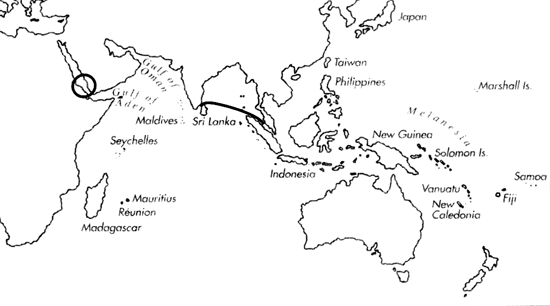
Skip Navigation Links
View access keys for this site.

Range: Andaman Sea, Bay of Bengal, S.E. India; ?Red Sea.
Description: Large, usually solid. Last whorl narrowly conoid-cylindrical to narrowly conical; outline almost straight, often slightly concave centrally. Aperture wider at base than near shoulder; exhalent notch about 1/3 of maximum diameter. Shoulder subangulate to angulate. Spire usually of moderate height, stepped; outline almost straight. Larval shell of about 3 whorls, maximum diameter 0.9-1.1 mm. First 4-7 postnuclear whorls tuberculate. Teleoconch sutural ramps slightly concave, with 0-2 increasing to 2-6 fine spiral grooves, generally with obsolete spiral striae in late whorls. Last whorl with very weak spiral ribs or ribbons at base.
| Shell Morphometry | ||
|---|---|---|
| L | 85-132 mm | |
| RW | 0.25-0.65 g/mm | |
| RD | 0.36-0.44 | |
| (-India 0.46 - 0.47) | ||
| PMD | 0.80-0.96 | |
| RSH | 0.16-0.24 | |
Ground colour white. Last whorl with fine light to dark brown reticulated lines and yellowish brown flecks and blotches. Blotches grouped in spiral rows, interspersed with broad brown axial and fine to coarse spiral lines. Lines producing very small to medium-sized tents arranged in 3 spiral bands, below shoulder and centre and at base. Larger tents concentrated between or near brown zones. Larval whorls beige to pinkish violet. First 2-3 postnuclear sutural ramps pale pink or white, immaculate. Following sutural ramps matching last whorl in colour pattern. Aperture white.
Periostracum yellowish grey, thin, translucent, smooth.
Animal similar in colour pattern to that of C. textile (Wee, 1972); however, foot not edged with orange-brown or red at ends, and tip of siphon orange rather than red (Roussy, pers. comm., 1994).
Radular teeth long and slender, with 2 opposed barbs adapically; long serration ending in cusp about 1/5 of the length from the base (Rolán, 1993).
Habitat and Habits: In 50-130 m, on mud and sand bottoms. C. bengalensis was observed to feed on gastropods (Wee, 1972).
Discussion: C. bengalensis is similar to C. gloriamaris and C. milneedwardsi. C. gloriamaris can be distinguished by its broader last whorl (RD 0.45-0.50), less angulate shoulder, more convex outline below shoulder, and by its finer pattern with smaller tents and 3 rather than 2 broad spiral bands of yellowish brown blotches on the last whorl. For comparison with C. milneedwardsi, see the Discussion of that species. Shells from S. E. India (Pl. 69, Fig. 3) differ from typical C. bengalensis in having a broader last whorl (RD 0.46-0.47). Specimens from the Red Sea (Pl. 69, Fig. 4) are so close to C. bengalensis, that we tentatively assign them to this species. The adult shell is smaller (L 65 mm) than typical C. bengalensis, has a broader last whorl (RD 0.48) and a more angulate shoulder; its colour pattern rather resembles that of C. milneedwardsi in its widely meshed arrangement and the absence of broad axial lines from the yellow-brown blotches.

C. bengalensis range map
This section contains verbatim reproductions of the accounts of 316 species of Conus from the Indo-Pacific region, from Manual of the Living Conidae, by Röckel, Korn and Kohn (1995). They are reproduced with the kind permission of the present publisher, Conchbooks.
All plates and figures referred to in the text are also in Röckel, Korn & Kohn, 1995. Manual of the Living Conidae Vol. 1: Indo-Pacific Region.
The range maps have been modified so that each species account has it own map, rather than one map that showed the ranges of several species in the original work. This was necessary because each species account is on a separate page on the website and not confined to the order of accounts in the book.
Return to framed version (returns to search page)